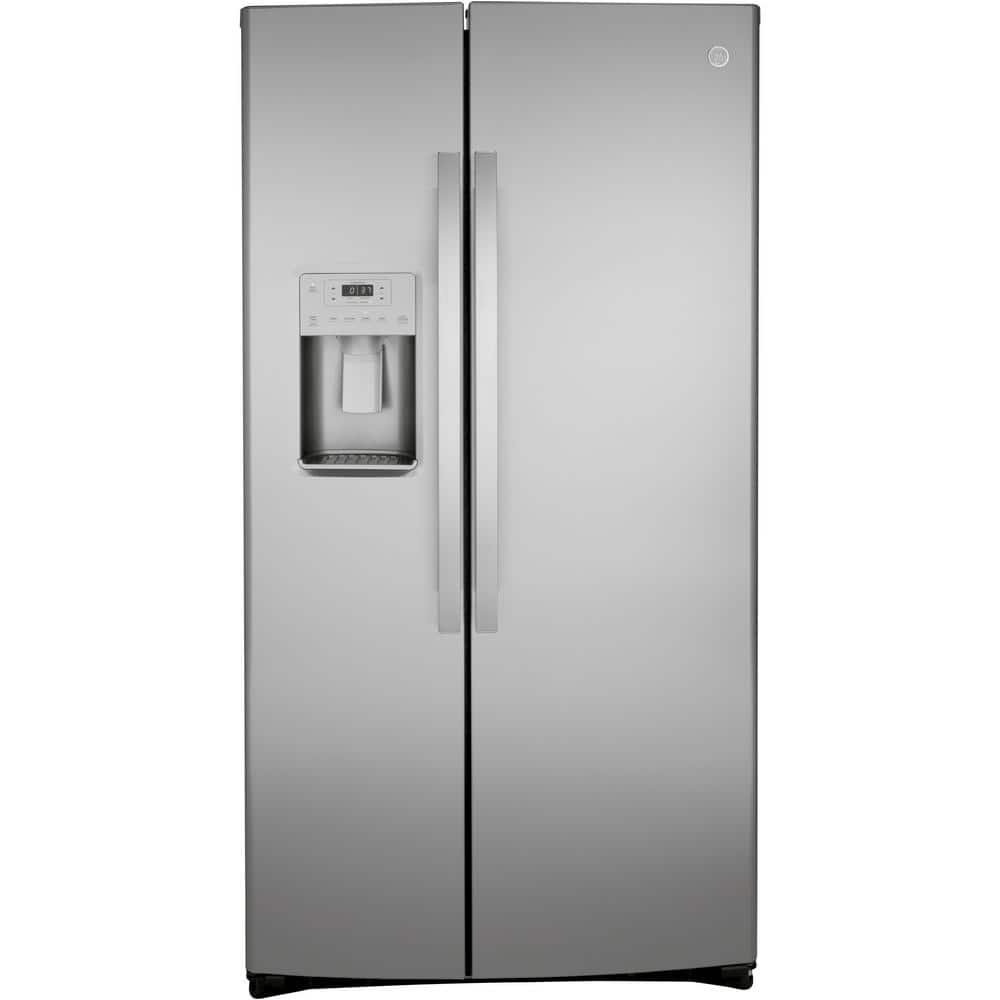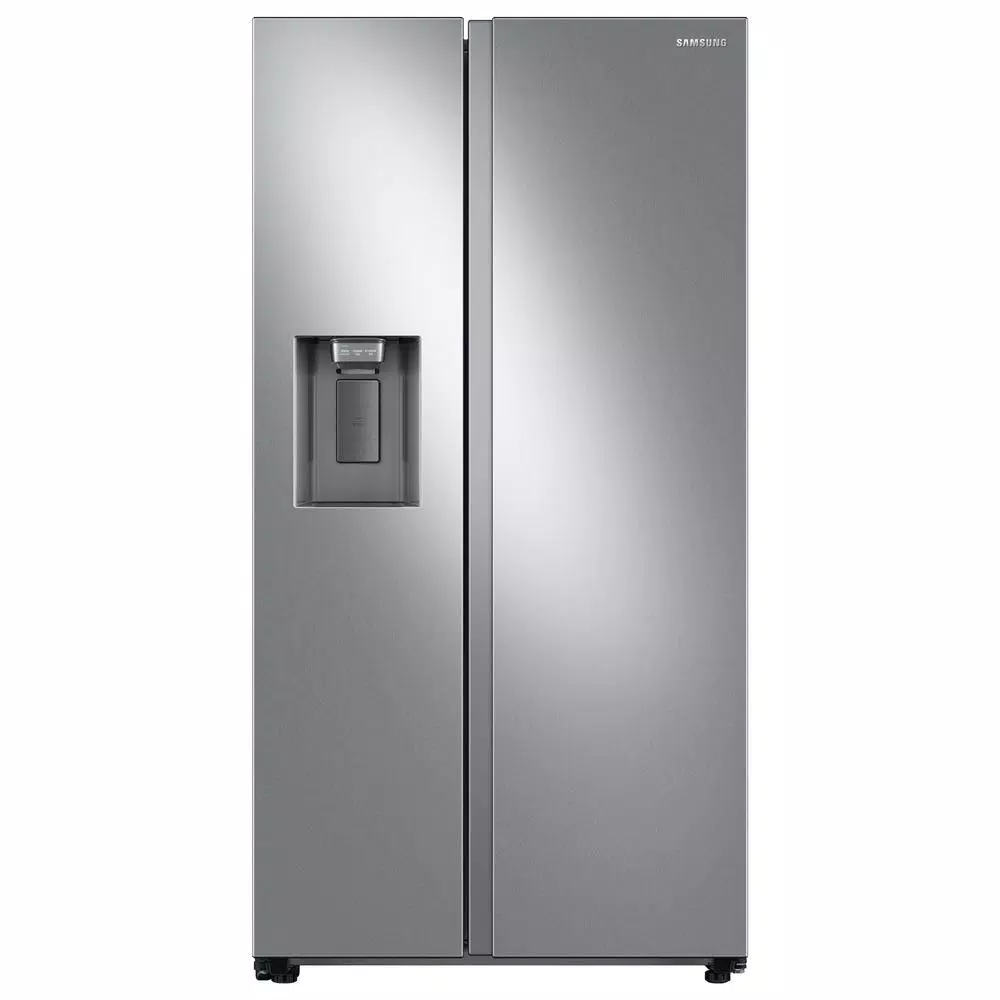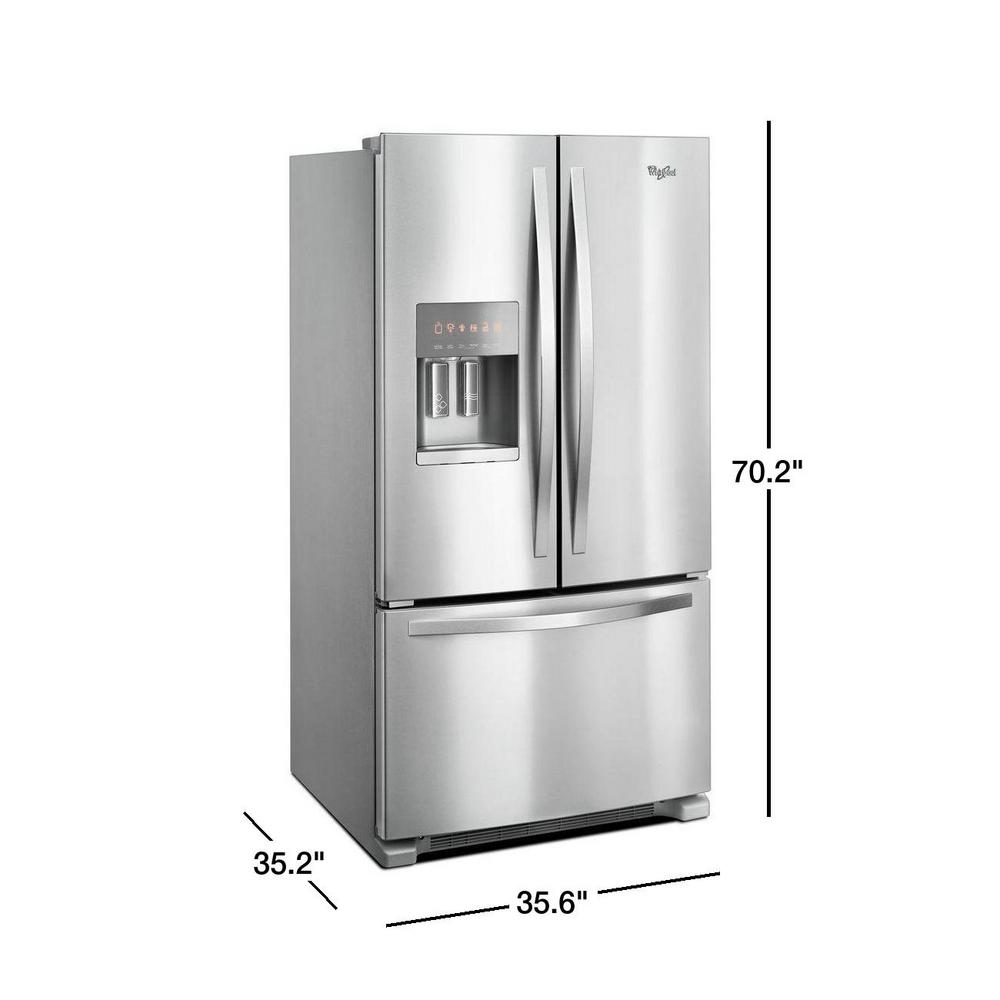GE 25.1 cu. ft. Side by Side Refrigerator in Fingerprint Resistant Stainless Steel
Showcase LED lighting makes items easy to spot and retrieve. Adjustable slide-out shelves extend the width of the refrigerator. Adjustable clear look door bins free up valuable shelf space.
Your GE 25.1 cu. ft. Side by Side Refrigerator in Fingerprint Resistant Stainless Steel has the GE Water filtration system, plus a GE Arctica icemaker with a special access door that puts ice within reach. The dispenser in your refrigerator provides cubes, crushed ice and chilled water. Adjustable slide-out, spill proof glass shelves with raised edges help contain spills, holding up to 12 oz. of liquid, to make cleanup quick and easy. GE appliances provide up-to-date technology and exceptional quality to simplify the way you live. With a timeless appearance, this family of appliances is ideal for your family. And, coming from one of the most trusted names in America, you know that this entire selection of appliances is as advanced as it is practical.
- Fingerprint resistant stainless – Easily wipe away smudges and fingerprints for a look that’s always sparkling clean
- Showcase LED lighting – Easily find even the smallest food items thanks to the flush showcase LED lights that illuminate every corner of the refrigerator and freezer
- Clean appearance – Enjoy a refrigerator with a streamlined design, including hidden hinges, white LED lighting, edge-to-edge glass shelves and a fingerprint-resistant stainless finish
- Adjustable slide-out shelves – Enjoy a polished look and easy-access cleaning with edge-to-edge glass shelves that extend the full width of the refrigerator
- Glass freezer shelves – Securely store a variety of items on glass shelves, including a sweet-spot shelf located above the ice bins – the coldest spot in the freezer
- Adjustable Clear Look door bins – Offers ideal space for large containers in the door and frees up valuable shelf space
- Color-match dispenser – Create a seamless look with a dispenser that is coordinated with the refrigerator finish
- Fresh food multi-level drawers – Provide the ideal environment for storing your fruits and vegetables
- Advanced water filtration uses XWF replacement filter – Reduces trace pharmaceuticals from water and ice (Removes 98% of ibuprofen, atenolol, fluoxetine, progesterone and trimethoprim. These pharmaceuticals are not necessarily in all users water)
- Approximate Dimensions (in.) – 69-1/2 H x 35-3/4 W x 34-3/4 D
- 4 Fresh Food Cabinet Shelves and 4 Freezer Cabinet Shelves
- Limited 1-year entire appliance warranty
-
Additional information
| Depth (Excluding Handles) | 32.75 |
|---|---|
| Depth (Including Handles) | 34.75 |
| Depth (Less Door) | 28.5 |
| Depth With Door Open 90 Degrees (In) | 42.25 |
| Height to Top of Door Hinge (in.) | 70.125 |
| Height to Top of Refrigerator (in.) | 69 |
| Product Depth x Height x Width (in.) | 34.75 x 69.5 x 35.75 |
| Refrigerator Width (In.) | 35.75 |
| Certifications and Listings | UL Listed |
| Manufacturer Warranty | Limited 1-year entire appliance warranty |
1 (one, unit, unity) is a number, numeral, and glyph. It is the first and smallest positive integer of the infinite sequence of natural numbers. This fundamental property has led to its unique uses in other fields, ranging from science to sports, where it commonly denotes the first, leading, or top thing in a group. 1 is the unit of counting or measurement, a determiner for singular nouns, and a gender-neutral pronoun. Historically, the representation of 1 evolved from ancient Sumerian and Babylonian symbols to the modern Arabic numeral.
In mathematics, 1 is the multiplicative identity, meaning that any number multiplied by 1 equals the same number. 1 is by convention not considered a prime number. In digital technology, 1 represents the "on" state in binary code, the foundation of computing. Philosophically, 1 symbolizes the ultimate reality or source of existence in various traditions.
Twenty-Five or 25 may refer to:
- 25 (number)
- one of the years 25 BC, AD 25, 1925, 2025
A fingerprint is an impression left by the friction ridges of a human finger. The recovery of partial fingerprints from a crime scene is an important method of forensic science. Moisture and grease on a finger result in fingerprints on surfaces such as glass or metal. Deliberate impressions of entire fingerprints can be obtained by ink or other substances transferred from the peaks of friction ridges on the skin to a smooth surface such as paper. Fingerprint records normally contain impressions from the pad on the last joint of fingers and thumbs, though fingerprint cards also typically record portions of lower joint areas of the fingers.
Human fingerprints are detailed, unique, difficult to alter, and durable over the life of an individual, making them suitable as long-term markers of human identity. They may be employed by police or other authorities to identify individuals who wish to conceal their identity, or to identify people who are incapacitated or deceased and thus unable to identify themselves, as in the aftermath of a natural disaster.
Their use as evidence has been challenged by academics, judges and the media. There are no uniform standards for point-counting methods, and academics have argued that the error rate in matching fingerprints has not been adequately studied and that fingerprint evidence has no secure statistical foundation. Research has been conducted into whether experts can objectively focus on feature information in fingerprints without being misled by extraneous information, such as context.
A refrigerator, commonly shortened to fridge, is a commercial and home appliance consisting of a thermally insulated compartment and a heat pump (mechanical, electronic or chemical) that transfers heat from its inside to its external environment so that its inside is cooled to a temperature below the room temperature. Refrigeration is an essential food storage technique around the world. The low temperature reduces the reproduction rate of bacteria, so the refrigerator lowers the rate of spoilage. A refrigerator maintains a temperature a few degrees above the freezing point of water. The optimal temperature range for perishable food storage is 3 to 5 °C (37 to 41 °F). A freezer is a specialized refrigerator, or portion of a refrigerator, that maintains its contents’ temperature below the freezing point of water. The refrigerator replaced the icebox, which had been a common household appliance for almost a century and a half. The United States Food and Drug Administration recommends that the refrigerator be kept at or below 4 °C (40 °F) and that the freezer be regulated at −18 °C (0 °F).
The first cooling systems for food involved ice. Artificial refrigeration began in the mid-1750s, and developed in the early 1800s. In 1834, the first working vapor-compression refrigeration, using the same technology seen in air conditioners, system was built. The first commercial ice-making machine was invented in 1854. In 1913, refrigerators for home use were invented. In 1923 Frigidaire introduced the first self-contained unit. The introduction of Freon in the 1920s expanded the refrigerator market during the 1930s. Home freezers as separate compartments (larger than necessary just for ice cubes) were introduced in 1940. Frozen foods, previously a luxury item, became commonplace.
Freezer units are used in households as well as in industry and commerce. Commercial refrigerator and freezer units were in use for almost 40 years prior to the common home models. The freezer-over-refrigerator style had been the basic style since the 1940s, until modern, side-by-side refrigerators broke the trend. A vapor compression cycle is used in most household refrigerators, refrigerator–freezers and freezers. Newer refrigerators may include automatic defrosting, chilled water, and ice from a dispenser in the door.
Domestic refrigerators and freezers for food storage are made in a range of sizes. Among the smallest are Peltier-type refrigerators designed to chill beverages. A large domestic refrigerator stands as tall as a person and may be about one metre (3 ft 3 in) wide with a capacity of 0.6 m3 (21 cu ft). Refrigerators and freezers may be free standing, or built into a kitchen. The refrigerator allows the modern household to keep food fresh for longer than before. Freezers allow people to buy perishable food in bulk and eat it at leisure, and make bulk purchases.
Stainless may refer to:
- Cleanliness, or the quality of being clean
- Stainless steel, a corrosion-resistant metal alloy
- Stainless Games, a British video game developer
- Stainless Broadcasting Company, a TV broadcaster based in Michigan, US
- Stainless Banner, the second national flag of the Confederate States of America
Steel is an alloy of iron and carbon with improved strength and fracture resistance compared to other forms of iron. Because of its high tensile strength and low cost, steel is one of the most commonly manufactured materials in the world. Steel is used in buildings, as concrete reinforcing rods, in bridges, infrastructure, tools, ships, trains, cars, bicycles, machines, electrical appliances, furniture, and weapons.
Iron is always the main element in steel, but many other elements may be present or added. Stainless steels, which are resistant to corrosion and oxidation, typically need an additional 11% chromium.
Iron is the base metal of steel. Depending on the temperature, it can take two crystalline forms (allotropic forms): body-centred cubic and face-centred cubic. The interaction of the allotropes of iron with the alloying elements, primarily carbon, gives steel and cast iron their range of unique properties. In pure iron, the crystal structure has relatively little resistance to the iron atoms slipping past one another, and so pure iron is quite ductile, or soft and easily formed. In steel, small amounts of carbon, other elements, and inclusions within the iron act as hardening agents that prevent the movement of dislocations.
The carbon in typical steel alloys may contribute up to 2.14% of its weight. Varying the amount of carbon and many other alloying elements, as well as controlling their chemical and physical makeup in the final steel (either as solute elements, or as precipitated phases), impedes the movement of the dislocations that make pure iron ductile, and thus controls and enhances its qualities. These qualities include the hardness, quenching behaviour, need for annealing, tempering behaviour, yield strength, and tensile strength of the resulting steel. The increase in steel's strength compared to pure iron is possible only by reducing iron's ductility.
Steel was produced in bloomery furnaces for thousands of years, but its large-scale, industrial use began only after more efficient production methods were devised in the 17th century, with the introduction of the blast furnace and production of crucible steel. This was followed by the Bessemer process in England in the mid-19th century, and then by the open-hearth furnace. With the invention of the Bessemer process, a new era of mass-produced steel began. Mild steel replaced wrought iron. The German states were the major steel producers in Europe in the 19th century. American steel production was centred in Pittsburgh, Bethlehem, Pennsylvania, and Cleveland until the late 20th century. Currently, world steel production is centered in China, which produced 54% of the world's steel in 2023.
Further refinements in the process, such as basic oxygen steelmaking (BOS), largely replaced earlier methods by further lowering the cost of production and increasing the quality of the final product. Today more than 1.6 billion tons of steel is produced annually. Modern steel is generally identified by various grades defined by assorted standards organizations. The modern steel industry is one of the largest manufacturing industries in the world, but also one of the most energy and greenhouse gas emission intense industries, contributing 8% of global emissions. However, steel is also very reusable: it is one of the world's most-recycled materials, with a recycling rate of over 60% globally.






by Brunner
The side by side GE refrigerator is beautifully designed with plenty of room and loaded with features.
by Rachel
We were impressed by the LED lighting, it makes the whole experience of opening the fridge/freezer a “whole new experience”. We also have not ever owned an outside filtered water dispenser. We all are including in that, as we do not have to fill our water jugs at our faucet water filter and wait for them to get cold in the fridge anymore:)
by Sassy
It’s spacious, has pull out shelves and I love the lighting!
by Ben
I prefer satin look versus shiny look. The in door shelves should be made out of sturdier plastic. One shelf pulled out by a child with items in it and when it hit the floor it shattered. Had to order another too expensive for the quality replacement. Received same flimsy easily crackable grade plastic as replacement. Freezer door Ice drop gate tends to freeze up not dispensing ice until one clears it. Ice dispenser seems to take too long to get ice into the cups lol. Some times have to shake the ice box in the freezer compartment to get it working. So with all this I find it a pricey solution although it has been effective so far.
by Daniel
We decided it was time to replace our existing 33 year old GE refrigerator before it died. lol Of course we would go with another GE. While the new one is less than 2 Cu ft larger, it seems much bigger. Lots of lights on the inside makes things easy to find. Freezer seems to have much more room due to efficiencies in the more modern design. The finger print resistant finish looks great.
by Donald
So far, so good. Plug and play, looks nice, probably should come with inert water filter.
by Ruby
The doors and handles are uneven which makes me disappointed in a name brand that would not have been proud enough to see that a simple thing like doors and handles were not done right. Other than that i love the fridge.
by Rebecca
Great quality and features. I really like the filter location inside the refrigerator.
by Lisa
Everything fits together well and best of all it’s quiet! Not like my old one that sounded like someone breaking in to my house every time the ice dropped. Like it so far.
by Earl
Love the size and features. The handles mark up easily with fingerprints but wipes off fairly easily.